Introduction
As a cutting-edge technology, outdoor curved LED displays are redefining the appearance and function of buildings in a unique way.
Have you ever thought that the exterior wall of a building can be turned into a dynamic painting? Or that the pillars of a building can tell a story?
Today, let us explore how outdoor curved LED displays can bring infinite possibilities to architectural design.
Table des matières
1. Technical advantages of outdoor curved LED displays
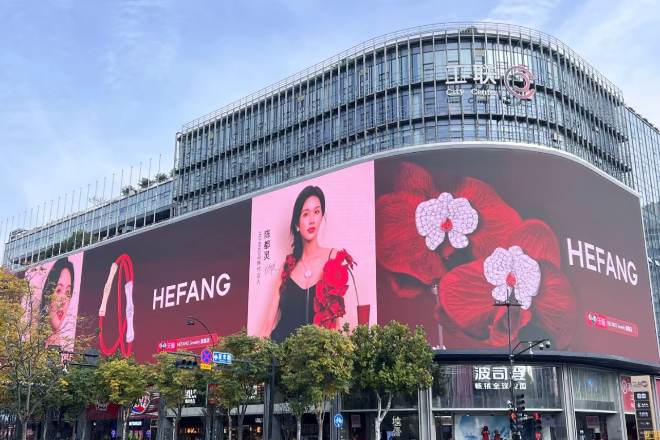
The biggest advantage of the outdoor curvedd LED display is that it can bend, unlike ordinary displays that are “hard”.
It has a curvature lock that allows it to bend 15 degrees inward and 10 degrees outward, which is much better than ordinary outdoor screens.
In this way, it can be easily “attached” to various curvedd buildings, such as arc-shaped building exterior walls or slightly curvedd building surfaces.
Although this display is not as “soft” as a écran LED flexible and cannot form a complete circle, it is very powerful outdoors, and it is not afraid of wind and rain, and can work steadily all the time.
Moreover, it is also very convenient to install, can be done piecemeal, and is very fast to dismantle.
If there is a temporary outdoor activity, it needs a large screen to create an atmosphere, which can be of great use, and it is not troublesome to dismantle after use.
In short, the outdoor curvedd LED display is a good helper that can be “flexible” and is both practical and beautiful.
The display effect of the outdoor curved LED display is really great! It is not only bright, but also very energy-saving. Even under the sun, it can display images and videos clearly.
The color is even better, bright and realistic, just like moving the real world to the display.
For example, on outdoor billboards, whether it is day or night, the advertising content can be clearly displayed to attract the attention of passers-by.
Moreover, it can automatically adjust the luminosité according to the light, which is both energy-saving and convenient.
This excellent display effect, whether it is used to display natural scenery or commercial advertisements, can make the audience’s eyes bright and feel particularly good.
The outdoor curved LED display is particularly “tough” and is not afraid of wind and rain, dust and moisture.
Its protection level is very high, such as IP65 or even higher, which means that it is waterproof, dustproof, moisture-proof, and can withstand all kinds of bad weather.
For example, at the seaside, it is not afraid of corrosion from seawater or humid air brought by the sea breeze. Even in the rainy season in the south, it will not malfunction due to humidity.
This kind of display screen has a long service life and can be used for more than ten years without any problem, which greatly reduces the trouble of replacement and maintenance.
In this way, it not only saves maintenance costs, but also reduces the trouble of maintenance, which is particularly worry-free.
2. What are the applications of outdoor curved LED display screens in buildings?
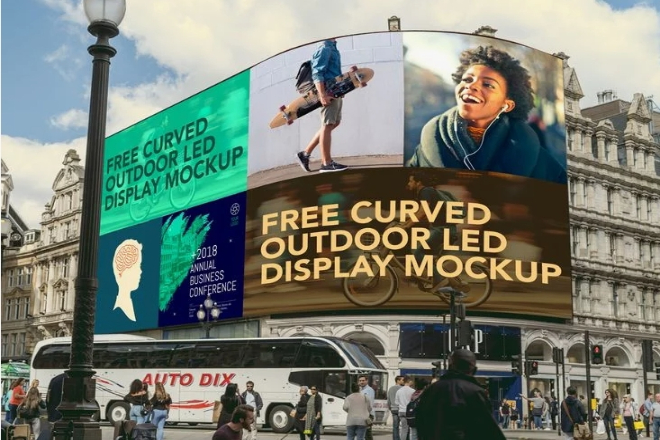
1). Building facade
1.1). Overall coverage
Imagine turning the exterior wall of an entire building into an oversized TV screen. This is the “overall coverage” gameplay of curved LED display screens.
For example, in commercial buildings or landmark buildings, this display screen is used to cover the facade of the building, and then various dynamic videos and pictures, such as advertisements, city promotional videos, and festival celebrations, are played.
In this way, the entire building is like a moving canvas, which is particularly eye-catching, making the building stand out in the city and become a beautiful landscape.
1.2). Local decoration
Sometimes, it is not necessary to cover the entire building with screens. It is only necessary to install curved LED display screens in some places to add a finishing touch.
For example, a screen is installed at the corner, top, or bottom of the building.
The hotel can install a screen above the entrance to play a welcome slogan or a promotional video of the hotel, so that guests can feel the enthusiasm as soon as they enter the door.
Commercial buildings can install a screen at the corner to display promotional information or brand stories to attract passers-by to take a closer look.
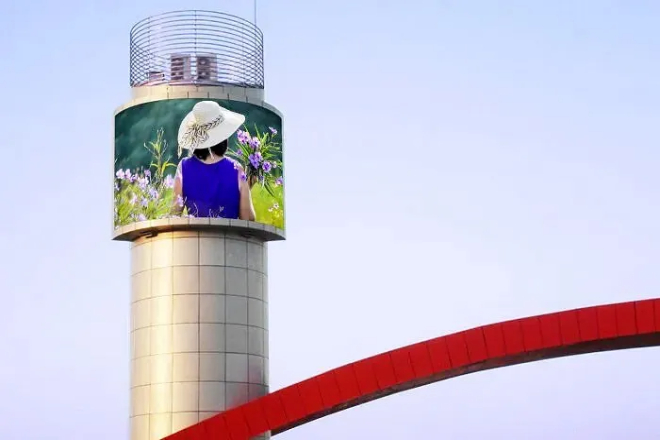
2). Special building structure
2.1). Building columns
Wrap the curved LED display screen on the column of the building, and the column becomes a glowing “artwork”.
For example, in shopping malls, those columns can be turned into gorgeous advertising columns to display brand logos, artistic patterns or dynamic effects.
In this way, the columns are no longer ordinary supports, but become highlights that attract customers’ attention, making the shopping mall more technological and artistic.
2.2). Building a glass curtain wall
If the curved LED display is combined with the glass curtain wall, it will be even more magical.
This display is transparent or translucent, which does not affect the lighting during the day and can become a dynamic display screen at night.
For example, the glass curtain wall of an office building can play a light show at night to show the company’s brand image or festive atmosphere.
In this way, the building not only looks transparent during the day, but also becomes a glittering “night scene star” at night.
2.3). Building a roof
It is also a good choice to install a curved LED display on the roof of the building. It can be used to display advertisements, or display the name and logo of the building.
For example, commercial buildings can display brand advertisements on the roof to attract the attention of people in the distance.
Landmark buildings can display the name of the building or iconic patterns on the roof, making the building more eye-catching in the city skyline without affecting the beauty of the building facade.
3. Design points of outdoor curved LED display screen in architectural application
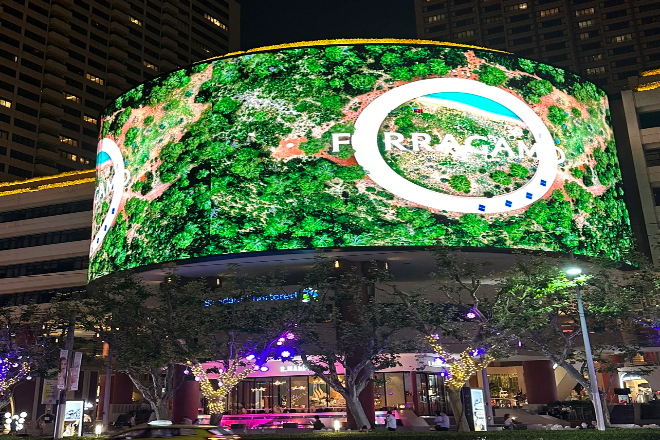
1). Integration of architectural style and display screen
When designing outdoor curved LED display screen, you have to think carefully about the style of the building itself.
If the building is in classical style, such as those traditional buildings with eaves and carvings, the content and shape of the display screen should preferably have some traditional elements.
For example, using traditional patterns and colors, or making the display screen round or square, and matching it with the decoration of the building, this not only retains the ancient charm of the building, but also adds the agility of modern technology.
If the building is in modern style, you can be bolder and use some innovative designs to highlight the sense of technology and fashion.
For example, make the display screen into an irregular shape, or use transparent or translucent materials, and integrate it with the glass curtain wall or steel structure of the building to create a cool futuristic feeling.
In this way, the display screen is not only a tool for displaying content, but also a part of the architectural style, making the entire building look more integrated.
2). Matching display content with architectural function
Different buildings have different uses, so the content of the display screen must also change accordingly.
The display screens in commercial buildings are mainly used for advertising and promoting commercial information, so the content must be attractive.
For example, installing a large, curved LED display screen on the outer wall of a centre commercial and playing high-definition advertising videos will definitely attract passers-by to take a few more glances and bring more attention to the business.
The display screens in cultural buildings are different. They should focus on cultural communication and art display.
For example, the display screens on the outer wall of a musée can display digitally restored images of cultural relics or historical stories, which can allow the audience to have a deeper understanding of the cultural background and enhance the cultural experience.
The functions of the display screens in public buildings are more extensive. They must take into account information release and public services.
For example, the display screens on the outer walls of aéroports or railway stations can display flight or train information in real time, which is convenient for passengers to check at any time. This is very practical.
In short, the content of the display screen should be determined according to the function of the building, so that it can better play its role.
3). Installation structure and safety
When outdoor curved LED displays are installed on buildings, safety is the top priority.
First of all, the weight, size, and installation location of the display screen must be considered to ensure that it can withstand the wind, its own weight, and the impact of external forces such as earthquakes.
For example, if you want to install a display screen on a high-rise building, you must go through a wind tunnel test. Otherwise, it will be too dangerous if the display screen shakes on a windy day.
In addition to safety, you must also consider the maintenance and repair of the display screen. It is best to design it as a detachable module so that broken parts can be easily replaced.
And reserve enough space for the staff to operate. In this way, the display screen can not only operate safely, but also facilitate daily maintenance and last longer.
4. Precautions for outdoor curved LED display screens in building types
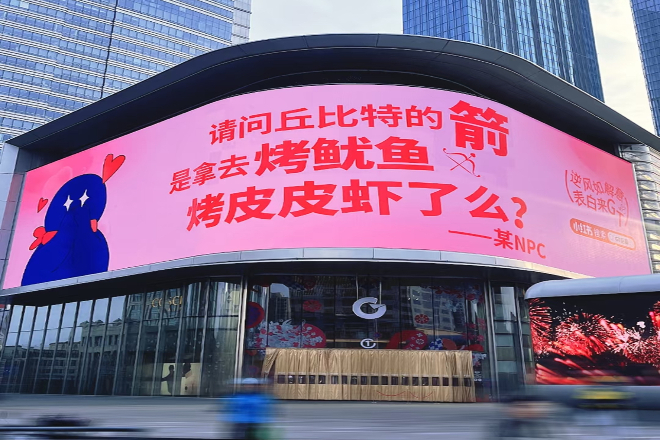
1). Commercial buildings
In commercial buildings, outdoor curved LED display screens are like super-large billboards.
The content of the advertisement must be legal and cannot be boastful, otherwise it will cause trouble.
Advertisements must be changed frequently, otherwise customers will get tired of them and lose interest. Brightness is also critical and cannot be too dazzling, otherwise it will affect people around.
The installation location is also important. People passing by must be able to see it at a glance and not be blocked by trees or other buildings.
In this way, the display screen can truly attract customers and help businesses make money.
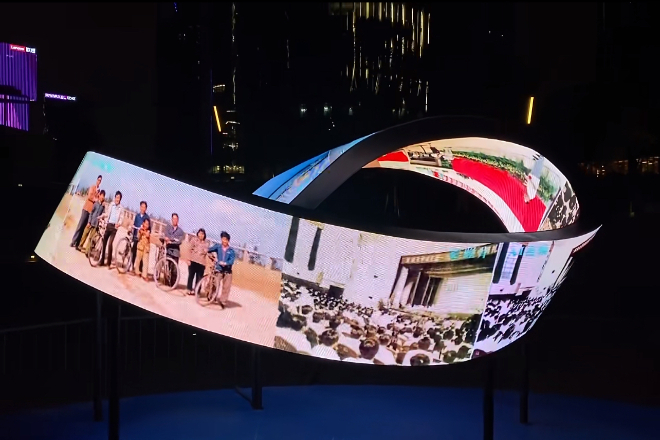
2). Cultural buildings
The display screens in cultural buildings, such as museums or art galleries, are used to display culture and art.
The content must be accurate and cannot be made up, otherwise it will mislead the audience.
For example, when displaying cultural relics or historical stories, the information must be true and reliable.
Color and display effects are also very important. The colors of artworks must be bright and realistic, so that the audience can feel the charm of art.
Moreover, the design of the display screen must match the architectural style and cannot destroy the overall beauty of the building.
For example, in ancient buildings, the display screen must be designed to be antique and integrated with the building.

3). Public buildings
The display screens in public buildings, such as airports, train stations, or subway stations, are mainly used to release information. The information must be accurate and updated in a timely manner.
For example, if the flight or train information is displayed incorrectly, passengers will miss the trip.
Moreover, considering the coming and going of people in these places, the display screen should preferably support multiple languages to facilitate people from different countries to view.
Most importantly, the display screen must have an emergency function.
In case of an emergency, such as a fire, the display screen can immediately switch to emergency mode and tell people how to evacuate, so as to ensure everyone’s safety.
5. Conclusion
The application of outdoor curved LED display screen not only brings a new visual experience to the building, but also gives the building a dynamic vitality.
From commercial advertising to cultural communication, from modern cities to classical architecture, its presence is everywhere.
Enfin, si vous souhaitez en savoir plus sur les écrans d'affichage LED, veuillez nous contacter.
Vous pourriez être intéressé par :
Other articles about curved LED display:
